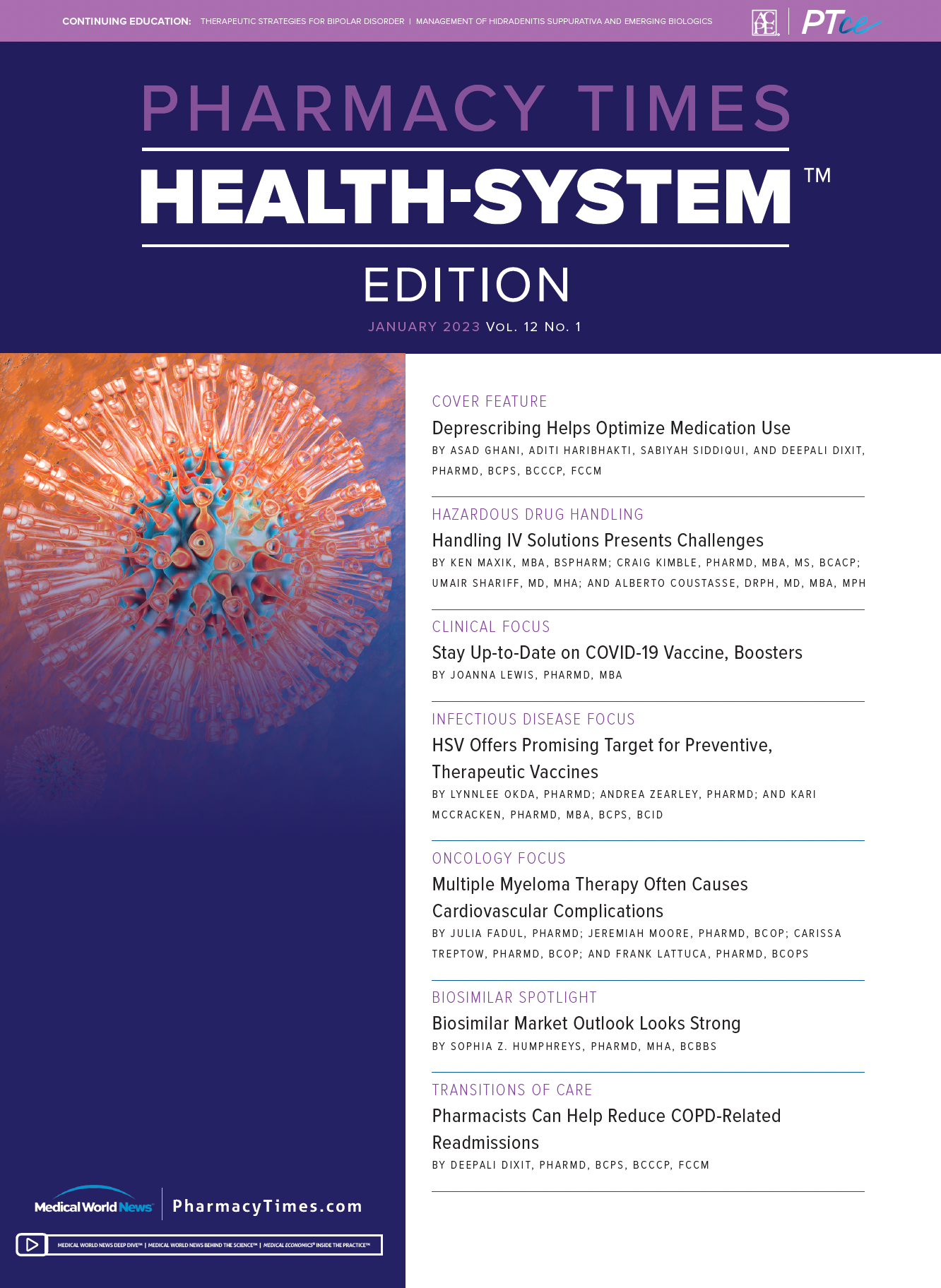News
Article
Pharmacy Practice in Focus: Health Systems
HSV Offers Promising Target for Preventive, Therapeutic Vaccines
Author(s):
Vaccination provides an opportunity to prevent and treat herpes simplex virus infection.
Herpes simplex virus (HSV) is an alpha herpesvirus with 2 subtypes: HSV-1 and HSV-2. HSV is part of the larger Herpesviridae family, which includes varicella-zoster virus (VZV), cytomegalovirus, and Epstein-Barr virus. As one of the world’s most prevalent sexually transmitted diseases, the World Health Organization estimates that 3.7 billion individuals under age 50 (67%) have HSV-1 infection globally. In addition, an estimated 491 million individuals aged 15 to 49 (13%) have HSV-2 infection worldwide.1
HSV-1 transmission most frequently occurs by oral-to-oral contact, causing oral ulcerations, encephalitis, and, less commonly, genital ulcers. HSV-2 is primarily a sexually transmitted cause of genital herpes and affects women nearly twice as often as men. After initial infection, HSV establishes a latent infection in the sensory ganglia, from which it may periodically reactivate due to physical or emotional stress, immunosuppression, sunlight exposure, or febrile illness. Most HSV infections are asymptomatic and unrecognized, adding to the ease of transmission.2 Epidemiological studies indicate that genital herpes enhances the transmission of HIV.3,4 Because of the high prevalence of the disease, the frequency of reactivation, ease of transmission, and association with HIV, there is a need to develop new prevention and management strategies, including vaccination.5
The success of the VZV vaccine has resulted in more attention for an HSV vaccine due to the similarities between acute and latent infections. However, critical differences in immune response elicited by each virus and the evasion mechanisms used by HSV make development more difficult.6 Various preventive and therapeutic vaccine candidates remain in development in both preclinical and clinical phases.
Preventive vaccines focus on primary infection prevention in a seronegative subject. Therapeutic vaccines aim to prevent HSV reactivation, decrease the number of recurrences, or reduce the severity or duration of clinical symptoms.7 A preventive vaccine would be ideal because it would prevent active disease and its sequelae and decrease transmission to others. However, therapeutic vaccines may be a more realistic focus to reduce disease severity and target a broader patient population, given the high number of seropositive individuals, especially at a young age.1
Current HSV vaccine candidates in various stages of development use DNA, modified messenger RNA (mRNA), protein subunit, and attenuated live virus vaccine technology to prevent development of or mitigate symptoms and spread of HSV. Protein subunit vaccines, such as the available VZV vaccine, are effective at eliciting an immune response against viral proteins. These vaccines are safer than live-attenuated vaccines but may not provide a long-lasting immune response.6,8 GSK plc developed a glycoprotein D2 subunit vaccine consisting of the HSV-2 glycoprotein D (gD2-ASO4). In clinical trials, gD2-ASO4 induced protection against genital HSV-1 infection and disease but not disease or infection with HSV-2. Several other subunit HSV vaccines have been tested in animal models, with varying levels of success.9
Nucleic acid vaccines include DNA plasmid vaccines and mRNA vaccines. These vaccines transfer genetic materials to cells to express and produce proteins that serve as immune system antigens. COR-1 is an example of an HSV DNA vaccine with 2 codon-modified plasmids.6 In a murine model, COR-1 induced cellular and humoral responses that protected from a lethal virus challenge and reduced viral latency.10 In a clinical trial of subjects infected with HSV-2, the vaccine demonstrated safety and reduced viral shedding after vaccine administration.11 A new formulation of a trivalent vaccine with HSV-2 glycoprotein C, D, and E as an mRNA vaccine was studied in animal models. Compared with a protein subunit vaccine, the mRNA vaccine provided a superior humoral response with higher titers of neutralizing antibodies, prevented HSV-2 infection of the dorsal root ganglia, and reduced viral shedding.12
Live-attenuated vaccines for HSV are effective at generating an immune response but remain challenging in safety. The R2 vaccine is a live attenuated HSV-1 strain encoding mutations in the pUL37 tegument protein, which is critical for nervous system invasion and the establishment of latency.6 Studies in an HSV-2–challenged guinea pig genital model have shown a decrease in the severity of HSV-2 disease, both acute and recurrent, and decreased viral shedding compared with a subunit vaccine.13 The HSV-2 DgD-2 vaccine is a single-cycle virus with a deletion in glycoprotein D and is protective in murine studies against 10 times the lethal dose of HSV-1 and HSV-2.14 Further studies in a murine model have shown that the DgD-2 vaccine prevents latent infection in the sacral ganglion, following the HSV-2 challenge in HSV-1 seronegative and seropositive mice.15
HSV is an easily transmissible disease, with high levels throughout th world. Therefore, the highly prevalent disease is a target for developing preventive and therapeutic vaccines to curtail the pervasiveness an associated complications of HSV. Although an HSV vaccine is not currently available, advancements in vaccine technology and the development of an effective VZV vaccine provide hope that a safe and effective HSV vaccine is right aroundthe corner.
References
- James C, Harfouche M, Welton NJ, et al. Herpes simplex virus: global infection prevalence and incidence estimates, 2016. Bull World Health Organ. 2020;98(5):315-329. doi:10.2471/BLT.19.237149
- Koelle DM, Wald A. Herpes simplex virus: the importance of asymptomatic shedding. J Antimicrob Chemother. 2000;45(suppl T3):1-8. doi:10.1093/jac/45.suppl_4.1
- Barnabas RV, Celum C. Infectious co-factors in HIV-1 transmission herpes simplex virus type-2 and HIV-1: new insights and interventions. Curr HIV Res. 2012;10(3):228-237. doi:10.2174/157016212800618156
- Looker KJ, Elmes JAR, Gottlieb SL, et al. Effect of HSV-2 infection on subsequent HIV acquisition: an updated systematic review and meta-analysis. Lancet Infect Dis. 2017;17(12):1303-1316. doi:10.1016/S1473-3099(17)30405-X
- Johnston C, Gottlieb SL, Wald A. Status of vaccine research and development of vaccines for herpes simplex virus. Vaccine. 2016;34(26):2948-2952. doi:10.1016/j.vaccine.2015.12.076
- Krishnan R, Stuart PM. Developments in vaccination for herpes simplex virus. Front Microbiol. 2021;12:798927. doi:10.3389/fmicb.2021.798927
- Sela M, Hilleman MR. Therapeutic vaccines: realities of today and hopes for tomorrow. Proc Natl Acad Sci U S A. 2044;101(suppl 2):14559. doi:10.1073/pnas.0405924101
- Herpes vaccine candidates. Precision Vaccinations. Reviewed December 12, 2022. Accessed December 19, 2022. https://www.precisionvaccinations.com/vaccines/herpes-vaccine-candidates
- Belshe RB, Leone PA, Bernstein DI, et al. Efficacy results of a trial of a herpes simplex vaccine. N Engl J Med. 2012;366(1):34-43. doi:10.1056/NEJMoa1103151
- Dutton JL, Li B, Woo WP, et al. A novel DNA vaccine technology conveying protection against a lethal herpes simplex viral challenge in mice. PLoS One. 2013;8(10):e76407. doi:10.1371/journal.pone.0076407
- Chandra J, Woo WP, Dutton JL, et al. Immune responses to a HSV-2 polynucleotide immunotherapy COR-1 in HSV-2 positive subjects: a randomized double blinded phase I/IIa trial. PloS One. 2019;14(12):e0226320. doi:10.1371/journal.pone.0226320
- Awasthi S, Hook LM, Pardi N, et al. Nucleoside-modified mRNA encoding HSV-2 glycoproteins C, D, and E prevents clinical and subclinical genital herpes. Sci Immunol. 2019;4(39):eaaw7083. doi:10.1126/sciimmunol.aaw7083
- Bernstein DI, Cardin RD, Smith GA, et al. The R2 non-neuroinvasive HSV-1 vaccine affords protection from genital HSV-2 infections in the guinea pig model. NPJ Vaccines. 2020;5(1):104. doi:10.1038/s41541-020-00254-8
- Burn C, Ramsey N, Garforth SJ, Almo S, Jacobs WR Jr, Herold BC. A herpes simplex virus (HSV)-2 single-cycle candidate vaccine deleted in glycoprotein D protects male mice from lethal skin challenge with clinical isolates of HSV-1 and HSV-2. J Infect Dis. 2018;217(5):754-758. doi:10.1093/infdis/jix628
- Burn Aschner C, Knipe DM, Herold BC. Model of vaccine efficacy against HSV-2 superinfection of HSV-1 seropositive mice demonstrates protection by antibodies mediating cellular cytotoxicity. NPJ Vaccines. 2020;5(1):35. doi:10.1038/s41541-020-0184-7
About the Authors
Lynnlee Okda, PharmD, is a PGY1 pharmacy resident at Ascension St John Medical Center in Tulsa, Oklahoma.
Andrea Zearley, PharmD, is a PGY1 pharmacy resident at Ascension St John Medical Center in Tulsa, Oklahoma.
Kari McCracken, PharmD, MBA, BCPS, BCIDP, is a clinical pharmacy specialist in infectious diseases at Ascension St John Medical Center in Tulsa, Oklahoma.

Newsletter
Stay informed on drug updates, treatment guidelines, and pharmacy practice trends—subscribe to Pharmacy Times for weekly clinical insights.






